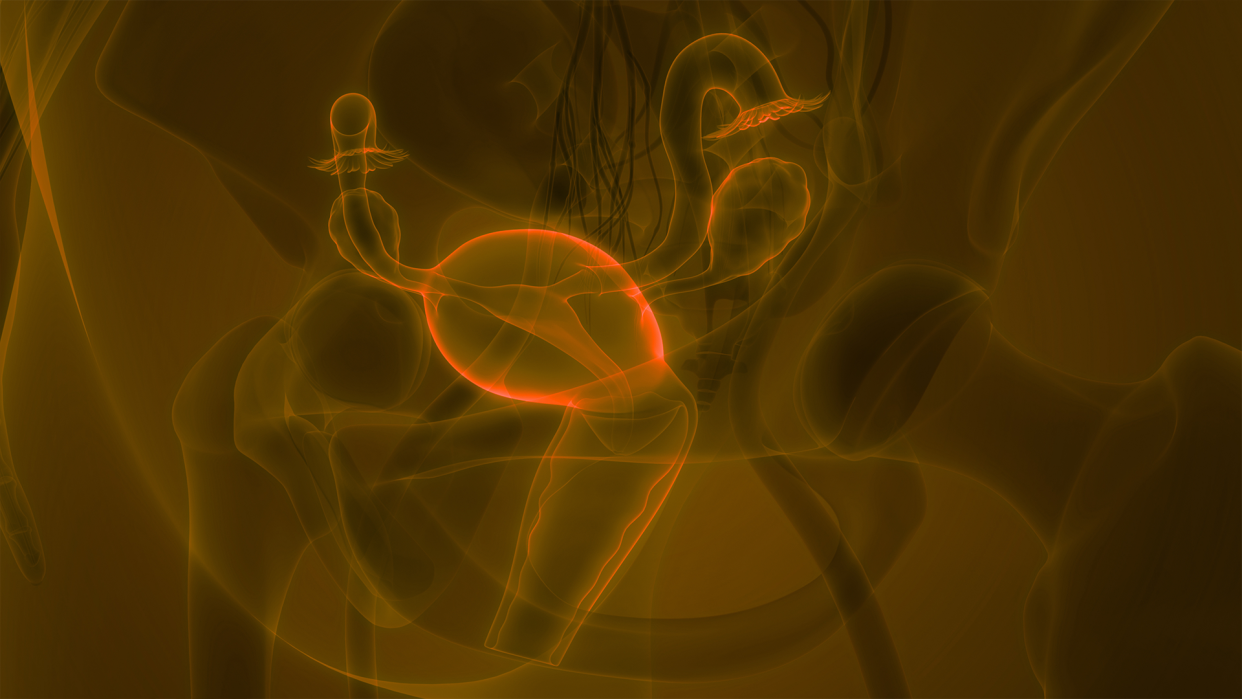Women who had ovarian cysts share their stories: 'I was sweating, throwing up from the intense pain'

Six weeks after giving birth to her first child, Andria Ortiz went to her ob-gyn for a routine postpartum check-up, which included a discussion about birth control. At that appointment, Ortiz tells Yahoo Life that her doctor told her that the mini pill was her only option if she wanted to continue nursing. She says that her doctor did not discuss with her the risks of this type of birth control, including an increased risk of developing ovarian cysts.
After a few weeks of being on the mini pill, Ortiz started having a sharp, burning pain in her abdomen. She called her obstetrician to get some help because she “knew something wasn’t right.” Ortiz says her doctor told her she was just having heartburn, but the pain didn’t go away.
After about a month of constant, burning pain that was getting progressively worse, she went to her doctor’s office sweating and shivering, “in absolute pain, begging for help.” Her doctor again told her she was having heartburn and sent her away with a prescription for antacid.
The situation continued to deteriorate. Ortiz says that about a month after her unsuccessful doctor visit, she found herself “in blinding pain, worse than ever.” Her husband rushed her to the emergency room. “I was sweating, throwing up from the intense pain,” she recalls. An ultrasound revealed that she “had an ovarian cyst that had just burst, hence the intense pain.”

At that point, Ortiz says “there was nothing they could do.” She was told that her body would absorb the fluid and she was discharged from the ER with medication to help control her pain.
“I felt so alone, scared, and like I had no choice but to just suffer through the pain until it was over,” Ortiz says.
What exactly is an ovarian cyst?
An ovarian cyst is a fluid sac that develops on the ovaries, explains Dr. Alan Lindemann, an obstetrician, maternal health expert and co-author of Modern Medicine: What You’re Dying to Know, tells Yahoo Life.
There are four types of ovarian cysts — functional cysts, PCOS cysts, benign ovarian tumor and malignant ovarian tumor — that range from harmless to fatal. “How much trouble they cause depends upon the kind of cyst you have,” Lindemann says, with treatment ranging from letting a cyst run its course to radical surgery.
What are functional cysts?
Every ovulating woman develops an ovarian cyst each month as a normal part of her cycle, says Lindemann. “This type of cyst grows slightly” until it reaches “its mature state before it ruptures and sends the egg out,” where it waits to be fertilized, explains Lindemann. If all goes according to plan, the cyst resolves on its own once the egg is discharged.
Dr. Joshua Cohen, a gynecologic oncologist at City of Hope Orange County, tells Yahoo Life that this type of ovarian cyst is “functional” and painless. However, a functional cyst may cause problems “when a sac on the ovary doesn't release an egg, causing the sac to swell with fluid,” explains Dr. Alexa Sueda, chief of obstetrics and gynecology for Kaiser Permanente in Hawaii.
Sueda says that even though “10 percent of women get larger than normal cysts” at some point in their lives, “most will never know it because there are no symptoms and they generally resolve on their own.”
What are PCOS cysts?
Women who have polycystic ovarian syndrome (PCOS) experience a different kind of ovarian cyst “due to hormone irregularities,” Lindemann explains. “These cysts do not rupture and release the enclosed egg ... in any predictable manner.”
Over time, women with PCOS may develop multiple unruptured cysts, which can be painful. Lindemann says that PCOS “responds to treatment,” and ovarian cysts caused by PCOS can be controlled with medication and lifestyle modifications, although many women with PCOS have a hard time getting pregnant without assistance.
Shifra Nerenberg, who was eventually diagnosed with PCOS, had her first ovarian cyst when she was 15. Her parents took her to a doctor because she had such unbearable abdominal pain and “the worst menstrual cramps ever that wouldn’t go away.” Her doctor recommended an ultrasound, which revealed a large cyst on her ovary. Nerenberg says she was told the cyst would probably pass on its own and that it wasn't large enough to manually remove.
More than 25 years later, Nerenberg says she still remembers “being in agony, without any resolution except time.” Now in her 40s, Nerenberg says she has “a strand of cysts inside” her ovaries and “sometimes has severe cramps before, during or after menstruation.” She has chosen to treat her PCOS with an herbal tincture she describes as a “lifesaver in dulling the pain.”

What is a benign ovarian tumor?
Some women develop ovarian cysts that are benign tumors, which is a slow-growing mass of tissue. This type of ovarian cyst is “relatively uncommon,” says Lindemann, affecting about 1 to 2% of adult women. “Benign ovarian tumors are usually one cyst,” he says.
The size of the cyst and whether it has septations — or divisions — that may indicate cancer is present dictate whether the cysts “can be watched…or needs to be surgically removed,” notes Lindemann.
Often, a doctor can “drain the cyst laparoscopically and remove enough of it to get a biopsy to rule out cancer,” he says. However, even benign cysts “can get to be very large — the size of a term pregnancy.” When tumors get to be that big, they need to be surgically removed, even if they are benign.
Tiffany Renyolds Blackburn had no idea she had ovarian cysts until one ruptured, sending her to the emergency room. She went to the hospital “because the pain was so sudden and awful.” She thought she was having appendicitis but an ultrasound revealed she had several ovarian cysts, one of which had just ruptured.
She received regular monitoring to watch the other cysts. One of them became wrapped around her fallopian tube resulting in “terrible constant pain.” Because Blackburn was being monitored, her doctor discovered via ultrasound that “it had some solid pieces to it, rather than all fluid,” which raised a red flag.
Blackburn had immediate laparoscopic surgery to remove the cyst. She lost a fallopian tube as a result of the surgery, but the cyst was benign. She has not had any problematic ovarian cysts since her surgery and was able to have two healthy children.
What is a malignant ovarian tumor?
Very rarely, ovarian cysts become malignant. Cohen explains that, unlike the functional cysts that play a role in reproduction, cancer can cause non-functional cysts to grow on the ovaries. “Unfortunately, the prognosis for these ovarian carcinomas has been and remains bleak because these cancers are found late,” given that there are no early symptoms, Lindemann points out.
Women with malignant ovarian cysts typically experience “abdominal pain” and notice “enlargement or mass formation,” once the disease is more advanced, Lindemann explains. The treatment for malignant ovarian cysts is surgery, and it usually “includes removal of both ovaries, both tubes, uterus, cervix and all of the little pieces of ovarian cancer growing in various places inside the abdomen,” in addition to chemotherapy, says Lindemann.
What increases the risk of developing problematic ovarian cysts?
There are several factors that can increase the risk of ovarian cysts, including hormonal problems, endometriosis and severe pelvic infections.
Another risk factor for developing ovarian cysts, according to Lindemann, is having used follicle-stimulating hormone (FSH) to hyperstimulate ovaries to produce eggs, such as in women undergoing fertility treatments or donating eggs.
However, certain factors may help lower the risk of harmful cysts, including malignant ovarian cysts. According to Lindemann, having children lowers the risk of ovarian cancer. “Pregnancy causes ovulation to stop, at least during the pregnancy,” he explains, which lowers the risk of developing harmful ovarian cysts.
Similarly, “using birth control pills also causes ovulation to stop,” he says, “and there has been an association with birth control pill use and less risk of ovarian cancer.”
Although evidence is somewhat mixed, some research shows a link between using talcum powder in the genital area and ovarian cancer. Because of this possible increased risk, Lindemann says that “women should not be using any kind of powder that has to do with talc” and, if needed, should consider using a powder with cornstarch as an alternative.
How are ovarian cysts diagnosed?
Sometimes a doctor will feel an ovarian cyst during a pelvic exam, notes Sueda. If a woman notices symptoms of an ovarian cyst, her gynecologist will typically order an ultrasound image of the pelvis.
A pelvic ultrasound can “confirm the presence of a cyst and determine if the cyst is filled with fluid or has solid areas,” explains Sueda. However, because ovarian cysts are so common and are rarely cancerous “they should not be cause for alarm,” she says, even if a woman's doctor recommends an ultrasound.
What are the symptoms of ovarian cysts?
Although most women won’t notice any signs with a typical ovarian cyst, they can cause symptoms in some cases. “A few symptoms to look out for are sudden onset of severe abdominal or pelvic pain, often on the side where the cyst is located, vomiting, fever, feeling faint, dizzy or weak with rapid breathing,” says Cohen.
Less often, women with ovarian cysts may experience “painful sex or menstruation, a dull ache in the lower back or thighs, the need to urinate frequently, weight gain or unusual bleeding,” Cohen adds. Additionally, he says that “cysts on the larger side may cause heaviness or fullness, bloating in the abdomen and pelvic pain.”
How are ovarian cysts treated?
Treatment for ovarian cysts is based on the type of cyst and the symptoms a patient is experiencing. “To relieve minor pain, warm packs and over-the-counter pain medicine can be used,” says Sueda. She adds that “birth control pills may prevent new cysts from forming because it stops ovulation when cysts may form.”
Surgery may be needed in cases where an ovarian cyst interferes with the person's ability to work or have normal activity, Sueda says. Or if the cyst is concerning because of its size or appearance, or when a large cyst “bleeds or causes severe pain because of rapid growth or twisting,” she says.
Cohen notes that most ovarian cysts are harmless. However, “a ruptured cyst or one that twists could cause severe and abrupt pain,” he says, “and if this happens, patients should seek medical attention at once.”
Because of her experience with ovarian cysts, Nerenberg encourages other women to advocate for themselves and “if needed, to see a specialist and have the tests done to confirm the diagnosis.”
Ortiz agrees, saying that she wants other women to trust their instincts, adding: “If you feel like something is wrong with your body, then something is wrong.”
Wellness, parenting, body image and more: Get to know the who behind the hoo with Yahoo Life's newsletter. Sign up here.


